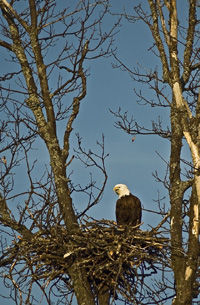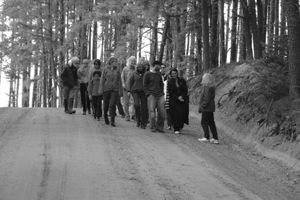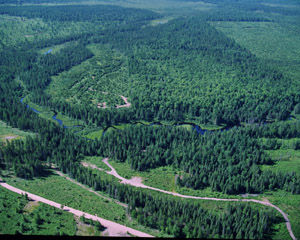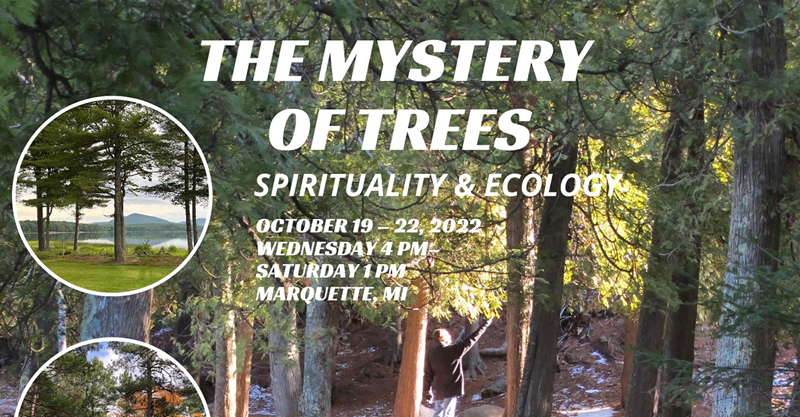Witness: A personal account of local efforts to stop the Kennecott Eagle Project Mine is from Marquette Monthly December, 2011
Jogging down the stairs at Heathrow Airport to the underground train running to London, I carry in my overnight luggage a small container of wild rice, formal letters from the Keweenaw Bay Indian Community, and a document signed by a hundred faith leaders. My twenty-eight-year-old traveling companion, a local organic farmer, writer and activist, carries in his duffle bag—along with a newly purchased bargain-basement suit—a bottle of homemade maple syrup and seven packets of background information on a controversial proposed sulfide mining project near our homes in Northern Michigan.
It’s April 2008 and we travel with support from a number of Michigan-based nonprofit groups, arriving in England a couple of days early for the annual general meeting of one of the world’s largest multinational mining corporations. For twenty years Rio Tinto has been listed as a top choice for investors on the London Stock Exchange. The company also has been documented as being responsible for some of the worst environmental and human rights violations that exist in the modern mining industry. We’re here because they’ll soon be coming, dependent on final government permits, to our neighborhood.
It’s been a long, contentious struggle. The Rio Tinto Group and its subsidiary, Kennecott Minerals, have long targeted precious metal ore bodies in rural northern Michigan. In 1992, shortly after former Michigan Governor John Engler offered up public lands for lease of mineral rights, Rio Tinto publicly announced its intention to establish a nickel and copper mine under the Salmon Trout River on the edge of the Huron Mountains, on public lands eight miles from Lake Superior, thirty miles north of Marquette.

The proposed site is covered with jack pine forests, linking underground aquifers to Lake Superior. In 1990, the fragile nature of nearby Lake Superior, with its distinctive role as headwaters for the other four Great Lakes, officially warranted this body of water a “Demonstration Area” for environmental protection by both the United States and Canadian governments.
The promise of trouble emerged as the company’s record was examined. It proved not to be a pretty picture. A heavy hitter in the corporate world, Rio Tinto’s market capitalization at the end of 2010, in spite of a massive global economic downturn, was more than $30 billion, a sum larger than the budgets of several countries. The company’s public relations strategy also became clear: Gloss over potential hazards of the sulfide mining process and minimize its poor environmental and human rights record, especially in dealing with indigenous peoples.
Ten thousand citizen signatures across the state were gathered to oppose the proposed mine, including those of a former state governor and university president. Company officials ignored the public outcry. In response, a coalition of nonprofit groups began to organize formally.
The National Wildlife Foundation first weighed in with legal support for the resistance, along with the Huron Mountain Club and one of Michigan’s Upper Peninsula major Native American communities. Tribal leaders from the Keweenaw Bay Indian Community claimed their rights under a 1842 treaty prohibited development of the area because those legal agreements ensure access and protection of traditional hunting, gathering and fishing grounds (along with practices of sacred ceremonies) on ceded treaty lands. Church leaders in the areas, sensitized to human rights and increasingly aware of Rio Tinto’s controversial mining record, moved forward in a public statement of solidarity with the tribe. Tensions heightened.

In 2008 a tribal delegate and three representatives from groups opposing the mine traveled to Rio Tinto’s annual meeting in London to voice opposition. I, as a clergyman, made the trip with Gabriel Caplett, a local farmer.
Last minute arrangements with the Church of England for our visit have been made through a colleague in Michigan, a newly elected Episcopal Bishop. For now, we’re depending on Richard Solly to coordinate our time and efforts in London.
A forty-nine-year-old articulate, insightful and disarmingly polite coordinator for the London Mining Network, this one-time seminarian and medieval studies student leads a bare-bones nonprofit organization made up of twenty-three affiliate agencies monitoring human rights and environmental violations by London-based mining companies. Following volunteer work in North America, Canada and Colombia with indigenous peoples, and a stint with Britain’s Church Commission for Racial Justice, he now spends his time publishing a weekly newsletter and organizing out of a modest, three room public housing flat, shared with author and well-known English mining activist Roger Moody.
Most of Solly’s work life these days dips in and out of research projects, strategic planning in London’s coffee shops, attendance at public hearings, and meetings with government officials on violations of human rights, especially in South America, where he spent time previously working with indigenous Colombian communities.
Tonight he’s arranged an initial meeting in the seminar room at London-based Amnesty International, housed in a modern two-story building tucked away at the end of a side street in Shoreditch. His suggestion is we design together a detailed strategy for addressing Rio Tinto’s board tomorrow during the question and answer time following Chairman Paul Skinner’s presentation of Rio Tinto’s 2008 annual report.
Entering the lobby of London’s Amnesty International, visitors are welcomed cordially but quietly. On the walls are photographs of victims of human rights violations mounted alongside images of clear-eyed children and community organizers from developing countries. It’s the end of a workday with only a receptionist present in the front office. Banks of computers, maps and crowded rows of files spill off into a lower-level working area.
Seven of us gather in the second floor meeting room. Three colleagues of Solly, veteran organizers and activists familiar with troublesome ethical issues in Rio Tinto’s worldwide operations, are at the table. Two bright, young journalists join us from a respected online London-based newsletter, Business and Human Rights, read daily by thousands of business executives and social activists around the globe.
Settings like this at Amnesty International remain disturbing to most visitors and high-profile politicians. The air one breathes here points to disturbing realities that conventional power brokers prefer to ignore, and for which mainstream media, most of the time, show little interest.
Our host, Shane Enright, trade union campaigns manager with Amnesty, approaches, dressed in a T-shirt and jeans. He welcomes us, explaining the security protocol to be followed. We’ve already passed through metal detectors, now we’re informed that without pass keys, the building can become “locked down” in a matter of seconds. We’re gently reminded this particular room is where victims of human rights violations have come to bear witness, where crimes against the poor are revealed, where torture and murder have been first brought to public acknowledgement.
Around the table the players introduce themselves. They’re dressed informally, exchange greetings and engage each other for a few moments in humorous, good-natured conversation. It’s obvious they’ve worked together. Anyone listening to their bantering quickly appreciates their level of analytical competence and street-savvy; they know the dance of power and politics.
They are Andrew Hickman, a former sculptor, with years volunteering with the Peace Movement in Indonesia, now a staff member with the London-based nonprofit Down to Earth; Geoff Nettleton, a one-time teacher and former community activist in the Philippines, Andy Whitmore, human rights researcher and writer with the nonprofit Indigenous Peoples Links. Joining us the next day will be Frank Nally, a Roman Catholic priest from Ireland, a former missionary in the Pacific Islands.
Later that evening at an English pub, conversations about the inner workings of Rio Tinto continue. Huddled around a corner table, fueled by pints of ale, our strategy emerges against the backdrop of a noisy televised soccer game.
Historians tell us that in settings like this, minus widescreen TVs, a seemingly unassailable worldwide slave trade was brought to its knees in the early 1840s. Over years of meetings in London’s public taverns and pubs, organizers leveraged their way as a presence into corners of Parliament, overcoming England’s centuries-old class lines and financial incentives, to lead that country to abolition of forced labor.
He comes to judge the nations,
A terror to his foes
Yet light of consolation
and blessed hope…
—An Advent hymn
The following day we meet again. Rio Tinto’s annual meeting has been scheduled for 11:00 a.m. at the Queen Elizabeth II Conference Centre near London’s Parliament. Five of us have received proxies that allow us to be present, fully legally, as stockholders. All of us are dressed in suits. I wear a clerical collar.
Lines of limousines and private cars of wealthy stakeholders and company executives vie for space in the center’s circular driveway. Security personnel stand post by the entrance; reporters move among the crowd interviewing visitors.
The big news for Rio Tinto is the large purchase option being negotiated with China. Reporters appear eager to interview members of our group, looking for inside information. When we mention we’re here to address issues of environmental damage and human rights, they turn away.
We pass through security screenings and enter a large, attractive meeting room with upbeat music. There are no photos of human rights victims on the wall, no images of children or village leaders from Third World countries. On a stage, elevated five feet above the main floor, is an elegant conference table facing stakeholders with black leather chairs for Rio Tinto board members. The fifteen directors enter, recorded music still playing in the background. Paul Skinner, the sixty-four year-old board chairman, opens the meeting with comments about security and safety, followed by board introductions. He proceeds with a thirty-minute overview of Rio Tinto’s 2008 fiscal year.
The meeting lasts three hours, closing with distribution of ballots for voting on ten resolutions. The printed annual report is slick, glossy, expensive. The fielding of critical questions from shareholders by the board chair is polished, orchestrated, cordial to antagonists, suggesting hints of professional coaching. Opening questions coming from the floor regard profit lines, compensation issues for the board, and heated opinions about China’s potential purchase of a sizable portion of the company.
One by one, intermittently, Solly and his fellow critics take the microphone. A hush falls across the auditorium during these half dozen interactions. Allegations received by the chair are responded to briefly, then deftly referred to the executive officer or other board members. An air of impatience fills the room. The three hundred stockholders are clearly here to monitor personal investments. There’s little interest in other matters.
Caplett, having traveled from Michigan, stands and speaks about the Eagle Project’s environmental threats to Lake Superior’s watershed. He’s done his homework but is summarily dismissed. Andrew Hickman rises and, backed with documents accusing the company of complicity in bribery and military payoffs in Papua, New Guinea, points out contradictions and omissions in the company’s annual report.
A pointed question is raised about Norway’s recent decision to divest its government pension fund of Rio Tinto stock, because of the severity of environmental and human rights violations attributed to the company. Most of Rio Tinto’s board members sit stone-faced, others shift in their chairs, visibly irritated.
A reception is scheduled to follow. We choose, instead, to leave and plan to debrief in the basement cafeteria of nearby Central Methodist Hall, site of the first meetings for the United Nations following WWII. Outside the conference center, chauffeurs patiently wait next to limousines for wealthy Rio Tinto stockholders.
It’s now late afternoon. Mist settles over London’s bustling streets. My colleagues have returned to their apartments and homes. I’ve decided to linger here in this part of the city, knowing it will be but a day or two before I leave England. Nearby, protests against government-supported injustices in Sri Lanka are underway in Parliament Square. British police stand at the edge of picket lines. Across Victoria Street, under the shadow of Big Ben, rises the steeple of Westminster Abbey, historic site for coronations of the royalty dating back to the eleventh century.
Hundreds of tourists and sightseers have lined up, as they do every day, to file through that medieval church, revered for centuries as the burial place for England’s kings and queens. Outside its stately, quarried walls, teenagers stand in groups mingling, sharing gossip and cigarettes. Crowds of visitors move about, using iPhones and cameras capturing digital images of the abbey’s architecture. A mix of languages, shifting colors and noise spills over from the church’s adjoining walkways.
Tourists normally are required to complete visits to the abbey by the end of each afternoon. I notice a small modest sign is posted on the Church’s wrought iron fence that reads, “Worship 5 P.M. Evening Prayer. Enter at the West Gate.”
As the last of the crowds are dissipating, I quietly enter the narthex and move toward a small, cordoned-off area. There are no more than twenty of us who now find ourselves sitting on wooden chairs before a small altar.

The service is a simple one with scripture lessons, a hymn and a brief spoken liturgy. Three Anglican priests are present, vested with surplices and exquisitely embroidered stoles. Together they lead our small congregation through prayers and responses in stately, Anglican fashion. The liturgy, conducted with proper airs of devotion, doesn’t elicit any coordinated response from us. Collectively, our spoken responses are formalized, but weak, barely audible.
I’m feeling dizzy, becoming more deeply aware of a disturbing collision of worlds. Earlier this very morning at the Queen Elizabeth Conference Centre, less than a hundred yards from where we pray, I’d witnessed a tribute to a world far different from this one. Responding to my question about what we might expect at an annual general meeting of a major international mining company, Richard Solly, walking with us in a light rain, replied with a discerning smile, “You’ll find annual meetings for companies like Rio Tinto to be secular liturgies of sorts: Well-choreographed, framed by music, ritual and ceremony. They’re all about bowing down. Reverently. In temples of money.”
Opening the Common Book of Prayer to follow the responsive reading, I’m reminded we never received any call back from my inside contact with the Archbishop of Canterbury. We did learn this morning, however, that the Church of England has more than $110 million of pension investments in Rio Tinto stocks.

A young woman in the row ahead of me, sitting alone, kneels on the marble floor for prayers. She uses no cushion. I choose to do the same, the medieval stone pressing into my knees. Outside, sounds of London’s traffic and milling crowds on Parliament Square are proclaiming a world of frenetic tourists and busy commerce. A young boyish priest leads us liturgically with measured cadence, cool detachment and a degree of innocence. He reads aloud, in studied Elizabethan English, from the Gospel of Luke. The echo of scripture drifts upward, finally inaudibly, into the rafters.
“For God hath showed strength with his arm: he hath scattered the proud in the imagination of their hearts. He hath put down the mighty from their seat: and hath exalted the humble and meek. He hath filled the hungry with good things: and the rich he hath sent empty away.”
The following day, The Guardian, London’s leading newspaper, covered Rio Tinto’s annual meeting, quoting Andrew Hickman, who challenged Rio Tinto’s record of human rights violations against workers and massive environmental degradation at the Grasberg gold mining project in West Papua.
That same morning, Richard Solly, the London-based mining activist, joined us to meet with a representative of the Church of England’s Pension Board and Ethical Investment Advisory Group. Letters from the Keweenaw Bay Indian Community protesting Kennecott’s Eagle Project were delivered personally that afternoon to the offices of that mining company’s leading investors in London’s financial district.
Since 2004, heated public debates, contentious meetings with government officials, prayer vigils and protests have taken place to highlight dangers to human health and potential environmental damage that many Marquette-area citizens believe will be an inevitable part of sulfide mining on the Yellow Dog Plains.

On May 2, 2010, Cynthia Pryor, a community leader opposed to Kennecott’s plans, was arrested in an act of conscience for trespassing on Kennecott’s leased land. In October 2010, Lois Gibbs, nationally known mother-turned-activist who led a successful grass-roots movement against one of North America’s largest petroleum companies at Love Canal in 1978, visited the mine site to stand in solidarity with those local citizens who continue protesting against sulfide mining in Marquette County.
Over the last year, the National Wildlife Federation, the Huron Mountain Club and the Keweenaw Bay Indian Community submitted motions for a legal injunction to prevent blasting into Eagle Rock. In August, an Ingham County Circuit Court Judge denied those motions.
On September 22, 2011, while still awaiting a final judgment, Kennecott Minerals Company began dynamiting the area adjacent to Eagle Rock to open a portal for their mining operations. Kennecott’s plan involves drilling an underground tunnel below the surface into the rock’s foundation in order to transport tons of ore for processing.
Frustrated citizens, opposed to Kennecott’s lack of transparency and wary of the state’s lack of oversight, have pledged an ongoing commitment to monitor the mining company’s operation for violations they believe will threaten both human health and the environment.
The gift of wild rice, harvested by Cree Indian people of Lake Superior’s north shore, and the small bottle of maple syrup from Superior’s south shore, which we brought in the spring of 2008 to Great Britain, were originally intended to be presented to the Archbishop of Canterbury. These gifts were instead, on the night before our departure from England, given to Richard Solly and his four comrades from the London Mining Network.
– Jon Magnuson
December 2011




